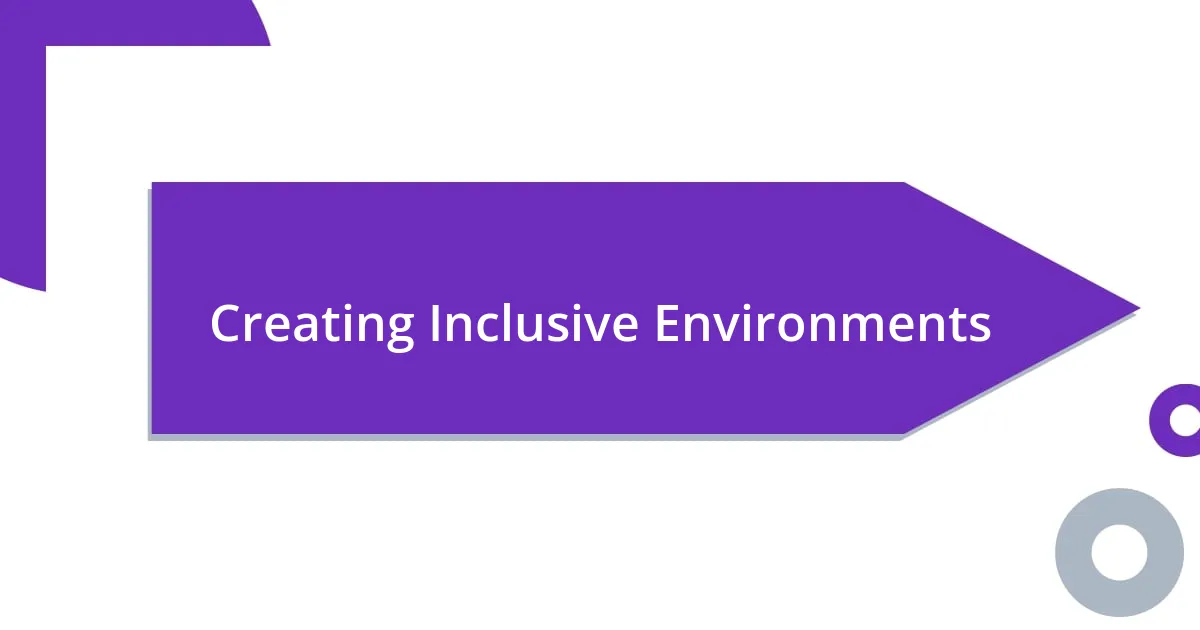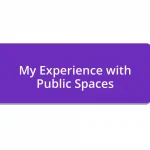Key takeaways:
- Public spaces serve as vital community connectors, fostering inclusivity and cultural exchange.
- Community engagement in public space projects enhances local ownership and sustainability.
- Accessibility and thoughtful design are crucial for ensuring all community members can enjoy public spaces.
- Vibrant programming and diverse activities transform ordinary areas into dynamic hubs of community life.

Understanding Public Spaces
Public spaces are more than just physical locations; they’re the heartbeat of a community. I remember wandering through a local park one sunny afternoon, surrounded by families laughing and friends catching up. It struck me then: How often do we take for granted these shared spaces that foster connections among us?
I often think about the role of accessibility in public spaces. During a visit to a bustling downtown area, I noticed a family struggling to navigate the uneven sidewalks with a stroller. This moment made me wonder: Are these spaces truly welcoming to everyone? It’s a question that lingers with me because, at their best, public spaces should be inclusive.
There’s something profoundly moving about witnessing people from diverse backgrounds come together in a public square. I once encountered a spontaneous gathering where artists showcased their talents, drawing in curious onlookers. It made me feel a sense of unity and pride in my community, reminding me how vital these spaces are for cultural exchange. What would happen if these vibrant interactions were missing? The essence of community would surely suffer.

Importance of Community Engagement
Engaging the community in public space projects is essential for creating environments that truly resonate with their needs and aspirations. I’ve attended several town hall meetings where residents voiced their desires for new playgrounds or gardens. Hearing their passion and creativity inspired me; it reminded me that when people come together, they amplify their collective vision.
Here are some key reasons why community engagement is crucial:
- Local Knowledge: Residents understand their neighborhood’s unique challenges and opportunities.
- Sense of Ownership: When community members are involved, they feel a stronger connection to the shared space.
- Diverse Perspectives: Active participation brings together various viewpoints, enhancing the overall design and functionality.
- Sustainability: Engaged communities are more committed to maintaining and improving their public spaces over time.
In my experience, I’ve seen the difference it makes when community members take charge of initiatives, like organizing clean-up days or art installations. These grassroots movements infuse vibrancy and ownership into spaces, leading to lasting change and connection. It’s not just about the physical transformation but the rekindling of bonds that happen when we collaborate.

Personal Experiences in Urban Areas
I have countless memories tied to urban areas, each one a thread in the fabric of my experiences. One particular evening stands out vividly; I was at a food truck festival in the heart of the city, where a diverse group of people gathered, united by the shared excitement of tasting new cuisines. The aromas wafted through the air, tempting my senses, while the sounds of laughter and lively conversations created a warm ambiance. It struck me that public spaces like this are not just about gathering; they are about creating lasting memories and a sense of belonging within the urban landscape.
Reflecting on accessibility, I’ve had my share of challenges navigating urban environments. One rainy day, I attempted to traverse a popular downtown area with a friend who uses a wheelchair. We encountered several curbs without ramps and crowded sidewalks that made simple movements feel daunting. This experience highlighted how essential it is for cities to prioritize inclusive designs. It’s not just about being able to access a location—it’s about ensuring that everyone can fully enjoy the vibrancy of public spaces without barriers.
Lastly, I cherish the moments spent at local parks, especially during community events. I remember attending a summer concert that transformed a typical Saturday evening into an unforgettable experience of togetherness. Families spread out picnic blankets, children danced with wild enthusiasm, and everyone seemed to forget their worries, even if just for a fleeting evening. It reminded me how public areas can ignite joy and foster connections. Have you ever had a similar experience? It surely reaffirms my belief that urban spaces must be embraced and celebrated for the joy they bring to our lives.
| Aspect | My Experience |
|---|---|
| Cultural Events | Food truck festival that fostered community bonding. |
| Accessibility | Challenges faced while navigating with a friend in a wheelchair. |
| Community Joy | Summer concerts creating unforgettable experiences. |

Observing Behavior in Public Spaces
Observing behavior in public spaces fascinates me. Just the other day, I spent some time in a bustling city square, and it was like watching a microcosm of society unfold. I noticed how strangers would interact with each other—some exchanging smiles, while others remained absorbed in their phones, seemingly oblivious to the vibrant world around them. It’s incredible how these moments of connection or disconnection in public areas can tell us so much about human nature.
I recall a particularly striking scene when a street performer began to play a lively melody. Suddenly, the mood shifted. People, who just moments before seemed lost in their own worlds, started to gather and engage with one another, clapping and dancing. It made me wonder—what is it about music that brings people together, even in passing? This spontaneous celebration was a reminder that public spaces can serve as a canvas for creativity and collective joy. They bridge gaps between people, sparking conversations and shared experiences.
Many times, I’ve observed how certain public spaces dictate the flow of behavior. Take a park, for instance; when I sit on a bench there, I watch parents encouraging their children to ride bikes or play freely. It’s a beautiful display of trust within a community, where everyone is watching out for one another. Yet, in quieter areas, like a library or art gallery, the atmosphere shifts to one of introspection. How does the design of a public space influence our interactions? Such observations leave me simultaneously intrigued and thankful for these environments that shape our daily lives.

Tips for Enhancing Public Spaces
Creating vibrant public spaces often starts with simple yet impactful changes. For example, when I visited a local plaza that introduced colorful seating and greenery, it transformed the atmosphere entirely. People lounged together, sharing stories and laughter under the sun, proving that the right environment can encourage community interaction. Have you ever noticed how just a few bright flowers or cozy benches can make a space feel inviting? It’s all about designing for connection.
In my experience, effective programming is vital for enhancing public spaces. I recall attending a weekly farmers’ market in a communal park where local vendors showcased their goods. The market didn’t just bring fresh produce; it fostered a sense of community pride. It made me realize that organizing events can turn an ordinary area into a dynamic hub of activity. What kind of events have you seen that breathe life into your local surroundings?
Lastly, it’s crucial to consider the inclusion of diverse activities. I once found myself at a community art festival that celebrated local talent, from musicians to painters. As I wandered through the vibrant displays, I felt an exhilarating sense of belonging. Spaces that offer varied experiences—be it through art, music, or sports—cultivate a richer tapestry of community life. How would you feel if your neighborhood provided these opportunities? In my view, these enhancements transform public spaces into true reflections of the communities they serve.

Creating Inclusive Environments
Creating inclusive environments within public spaces requires thoughtful consideration of all community members. I remember visiting a neighborhood park designed with wide pathways and accessible ramps. Watching families easily navigate with strollers, people using wheelchairs, and friends biking together made me realize how impactful these features are. Have you ever noticed how easy access can turn a barrier into a bridge? It’s a simple yet profound change.
Diversity in design is another vital aspect. I once attended a community meeting where residents shared stories about what they wanted to see in their local spaces. It struck me how passionate everyone was about including features for different activities—basketball courts, quiet reading nooks, and even spaces for public art. This dialogue not only empowered community members but also led to a design that truly reflected the needs of everyone. How often do you feel your voice is heard in local developments?
Lastly, I’ve observed how the presence of cultural elements can enrich a public space. At a recent outdoor festival celebrating various heritages, I felt the vibrant mix of music, food, and traditions. It wasn’t just an event but a celebration of identity that drew people in—making connections that felt organic. Spaces that honor and showcase diverse backgrounds not only make everyone feel welcome but also promote a deeper understanding of one another. What if every public space had such opportunities for connection? In my view, embracing diversity truly creates a sense of one community.

Reflecting on My Overall Experience
Reflecting on my overall experience with public spaces, I can’t help but think about the sense of belonging they foster. One sunny afternoon, I found myself at a waterfront park, where families and friends sprawled out on the grass, sharing food and laughter. It brought me immense joy to witness strangers coming together, united by a shared space, and it made me realize the extraordinary power these environments have to create community bonds.
I often reflect on how public spaces can change based on simple choices. I remember walking through a newly renovated square with vibrant murals and inviting seating areas. The atmosphere buzzed with energy that day—people were chatting, kids played nearby, and some musicians filled the air with lively tunes. Have you ever felt that electric connection among strangers, all brought together by the aesthetic of a space? That’s when I understood how thoughtfully designed surroundings can spark joy and foster interaction.
At times, I’ve also encountered public spaces that felt isolating, which stands in stark contrast to my previous experiences. I recall one park that, while beautiful, had few pathways and limited seating. It felt daunting and somewhat discouraging to find a place to gather. What happens when a space designed for the public doesn’t invite people in? It left me pondering about the importance of accessibility and inviting designs in shaping our shared experiences. Ultimately, these reflections reinforce my belief that the quality of public spaces profoundly shapes the fabric of our communities.












